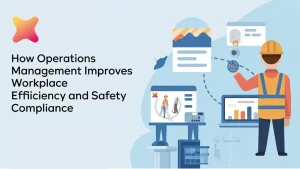Why Every Workplace Needs an Emergency Action Plan (EAP)

This guide explains what an Emergency Action Plan (EAP) is, why OSHA requires it, and how to design one that protects employees and keeps your workplace compliant. You’ll learn about risk assessment, role assignments, communication protocols, training practices, and regular reviews. Use the checklist below to craft or update your EAP with confidence.
Workplace emergencies whether fires, chemical spills, active threats, or power outages strike without warning. Yet many organizations still lack a structured and up-to-date Emergency Action Plan (EAP), putting employees and operations at risk.
Whether you manage a manufacturing plant, construction site, or corporate office, a well-crafted EAP isn’t just an OSHA requirement it’s essential for protecting your people, maintaining operations, and avoiding costly compliance issues.
Here’s what you’ll learn in this guide:
- What an Emergency Action Plan is (and why it matters)
- The 7 key components every EAP must include
- How to train your team and run effective drills
- How digital tools like WorkAware make planning, compliance, and communication easier
What Is an Emergency Action Plan (EAP)?
An Emergency Action Plan (EAP) is a written safety document required by OSHA (Occupational Safety and Health Administration) for workplaces with more than 10 employees, under standard 29 CFR 1910.38. It outlines exactly how employees should respond during emergencies such as fires, chemical spills, natural disasters, or workplace violence incidents.
7 Key Components of an Effective Emergency Action Plan
- Risk Assessment – Identify hazards (fires, spills, natural disasters) unique to your workplace.
- Clear Evacuation Procedures – Define routes, assembly points, and accessibility protocols.
- Assigned Roles & Responsibilities – Appoint coordinators, wardens, and first responders.
- Emergency Communication Plan – Use alerts, contact lists, and post-incident reports.
- Employee Training & Drills – Run regular training and realistic practice scenarios.
- Routine Review & Updates – Review annually or after any workplace changes.
- Post-Incident Procedures – Include documenting the event through a detailed workplace incident report , along with medical response actions and recovery protocols. These reports help safety teams analyze causes, prevent recurrences, and strengthen future emergency preparedness.
Why Is an Emergency Action Plan Important?
Beyond fulfilling a legal requirement, an EAP can significantly enhance your workplace emergency preparedness, OSHA compliance, business continuity in the face of unexpected incidents. Here’s how:
1. Enhances Employee Safety
Emergencies happen unexpectedly. With an EAP, employees know exactly what steps to follow during critical situations like fires, earthquakes, active shooter events, or toxic exposure. This clarity reduces panic, streamlines evacuation, and minimizes injuries or fatalities.
Example: During a fire drill at a mid-sized manufacturing plant, employees with prior EAP training evacuated the facility 40% faster than teams without training, highlighting how preparation can save lives.
2. Ensures OSHA Compliance
Compliance with OSHA’s emergency planning requirements is mandatory. Failure to comply can lead to citations, fines, and increased liability. In addition to OSHA 1910.38, industry-specific standards may require additional preparedness measures, particularly in high-risk sectors like construction or chemical manufacturing.
Pro Tip: OSHA provides a model EAP template that can be adapted to your workplace conditions.
3. Reduces Emergency Response Time
An EAP creates structure and predictability in chaotic situations. By assigning specific roles and responsibilities, such as evacuation coordinators or first aid responders, your business ensures everyone knows what to do without hesitation. This reduces confusion and enables faster decision-making.
4. Minimizes Business Disruptions
Emergencies can grind operations to a halt. An effective EAP addresses the immediate crisis and includes a business continuity plan that outlines how to resume essential functions. Reducing downtime helps prevent financial losses, maintain productivity, and protect your reputation.
5. Builds a Strong Safety Culture
Employees are more engaged and committed when they feel safe. A robust EAP demonstrates that the organization is proactive about workplace safety. This investment in team member well-being boosts morale, retention, and trust in leadership.
Office Insight: In one corporate setting, implementing an EAP improved team member satisfaction scores by 15%, with staff reporting they felt more secure and valued by management.
Real-World Applications of Emergency Action Plans
Let’s look at a few real scenarios where an EAP made a difference:
- Healthcare Facility: Thanks to its EAP, a hospital in Texas successfully relocated patients from one wing to another during a storm warning, minimizing risk and ensuring continuous care. Incorporating journey management for staff movements helped ensure everyone was accounted for and resources were coordinated efficiently.
- Educational Institution: A school district implemented lockdown drills as part of their EAP. During an actual security incident, students and teachers responded quickly, reducing potential harm. Tracking staff travel between campuses as part of journey management made coordination smoother.
- Small Business: After a localized power outage, a retail store followed its EAP to evacuate customers safely and restore operations. Including journey management for offsite personnel ensured that field staff could operate safely and maintain communication during the disruption.
How to Develop an Effective Emergency Action Plan
Creating an EAP doesn’t have to be overwhelming. Here’s a step-by-step guide to help you craft a plan tailored to your organization’s needs:
1. Conduct a Workplace Risk Assessment
Identify potential emergencies that could affect your workplace. This includes internal threats (e.g., electrical fires, chemical spills) and external ones (e.g., floods, earthquakes, civil unrest).
2. Involve Employees in the Planning Process
Employees who participate in safety planning are more likely to understand and follow emergency procedures. Gather feedback from various departments and include employees with specialized knowledge.
3. Define Evacuation Routes and Assembly Points
Use clear, visible signage and make evacuation routes accessible for individuals with disabilities. Conduct regular evacuation drills to reinforce the process.
4. Assign Roles and Responsibilities
Assign specific roles, such as fire wardens, floor supervisors, first aid providers, and communication leads. Provide role-specific training to ensure they can carry out their duties effectively.
5. Develop Communication Procedures
Ensure you have a way to communicate both internally and externally during emergencies. This may include loudspeakers, text alert systems, two-way radios, or emergency contact lists.
6. Train Employees and Conduct Regular Drills
Training shouldn’t be a one-time activity. Schedule annual or semi-annual refresher courses, and test different scenarios during drills to identify gaps in your plan.
7. Review and Update the EAP Regularly
Changes in workplace conditions, new machinery, staffing changes, or building renovations can impact your emergency plan. Review your EAP at least once a year or after any significant change or incident.
Legal Requirements for an EAP
Under OSHA regulations (29 CFR 1910.38):
- Workplaces with more than 10 employees must keep a written EAP.
- Employers must review the plan with each employee when it is created, when roles change, or when the plan is updated.
Failure to meet these requirements can result in OSHA citations, fines, or increased liability in the event of an incident.
The Takeaway
An Emergency Action Plan (EAP) isn’t just a compliance requirement—it’s a vital workplace safety tool that protects lives, preserves property, and ensures business continuity. Implementing a well-structured EAP empowers your team to respond confidently to fires, chemical spills, natural disasters, or other unexpected emergencies.
To make this process even more efficient, integrated solutions like Business Management Software can help streamline every aspect of emergency planning. From assigning roles and tracking responsibilities to managing drills and maintaining compliance records, the right software ensures nothing falls through the cracks.
Investing in such tools not only strengthens your safety culture but also enhances employee confidence, reduces operational downtime, and provides a clear system for continuous improvement. Discover how WorkAware can simplify emergency preparedness, optimize your safety workflows, and keep your team ready for any situation—get started today.
Frequently Asked Questions About Emergency Action Plans (EAPs)
Developing an Emergency Action Plan (EAP) is more than a compliance task—it’s one of the most practical workplace safety tips for protecting employees and maintaining operational stability. A strong EAP improves workplace safety, reduces emergency response time, and ensures compliance with OSHA regulations. It helps minimize property damage, support business continuity, and gives employees the clarity they need to act calmly and efficiently during a crisis—saving lives and limiting disruptions.
Yes. According to OSHA regulations, businesses with more than 10 employees are legally required to have a written Emergency Action Plan (EAP). This ensures the safety of employees during emergencies and helps organizations remain compliant with workplace safety laws.
An Emergency Action Plan should cover a wide range of potential workplace emergencies, including:
Fires
Natural disasters (like earthquakes, floods, hurricanes)
Chemical spills or hazardous material exposure
Power outages
Acts of workplace violence or other security threats
The EAP should be customized based on the specific risks associated with your business or industry.
Typically, the safety manager or human resources (HR) department takes the lead in developing the EAP. However, the most effective plans are created with input from multiple departments, including operations, facilities, and senior leadership. A collaborative approach ensures the EAP is thorough and practical for all teams involved.






